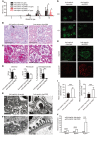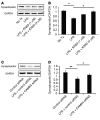CaMK4 compromises podocyte function in autoimmune and nonautoimmune kidney disease
- PMID: 29985166
- PMCID: PMC6063476
- DOI: 10.1172/JCI99507
CaMK4 compromises podocyte function in autoimmune and nonautoimmune kidney disease
Abstract
Podocyte malfunction occurs in autoimmune and nonautoimmune kidney disease. Calcium signaling is essential for podocyte injury, but the role of Ca2+/calmodulin-dependent kinase (CaMK) signaling in podocytes has not been fully explored. We report that podocytes from patients with lupus nephritis and focal segmental glomerulosclerosis and lupus-prone and lipopolysaccharide- or adriamycin-treated mice display increased expression of CaMK IV (CaMK4), but not CaMK2. Mechanistically, CaMK4 modulated podocyte motility by altering the expression of the GTPases Rac1 and RhoA and suppressed the expression of nephrin, synaptopodin, and actin fibers in podocytes. In addition, it phosphorylated the scaffold protein 14-3-3β, which resulted in the release and degradation of synaptopodin. Targeted delivery of a CaMK4 inhibitor to podocytes preserved their ultrastructure, averted immune complex deposition and crescent formation, and suppressed proteinuria in lupus-prone mice and proteinuria in mice exposed to lipopolysaccharide-induced podocyte injury by preserving nephrin/synaptopodin expression. In animals exposed to adriamycin, podocyte-specific delivery of a CaMK4 inhibitor prevented and reversed podocyte injury and renal disease. We conclude that CaMK4 is pivotal in immune and nonimmune podocyte injury and that its targeted cell-specific inhibition preserves podocyte structure and function and should have therapeutic value in lupus nephritis and podocytopathies, including focal segmental glomerulosclerosis.
Keywords: Autoimmunity; Calcium signaling; Calmodulin; Lupus; Nephrology.
Conflict of interest statement
Figures









Comment in
-
Pivotal role of CaMK4 in podocyte injury.Nat Rev Nephrol. 2018 Oct;14(10):598. doi: 10.1038/s41581-018-0042-2. Nat Rev Nephrol. 2018. PMID: 29995833 No abstract available.
Similar articles
-
Calcium/Calmodulin Kinase IV Controls the Function of Both T Cells and Kidney Resident Cells.Front Immunol. 2018 Oct 1;9:2113. doi: 10.3389/fimmu.2018.02113. eCollection 2018. Front Immunol. 2018. PMID: 30333818 Free PMC article. Review.
-
Fasudil compensates podocyte injury via CaMK4/Rho GTPases signal and actin cytoskeleton-dependent activation of YAP in MRL/lpr mice.Int Immunopharmacol. 2023 Jun;119:110199. doi: 10.1016/j.intimp.2023.110199. Epub 2023 Apr 24. Int Immunopharmacol. 2023. PMID: 37094544
-
Calcium calmodulin kinase IV deficiency in podocytes prevents the development of lupus nephritis.Clin Immunol. 2025 Feb;271:110427. doi: 10.1016/j.clim.2025.110427. Epub 2025 Jan 9. Clin Immunol. 2025. PMID: 39793862
-
Lupus Nephritis IgG Induction of Calcium/Calmodulin-Dependent Protein Kinase IV Expression in Podocytes and Alteration of Their Function.Arthritis Rheumatol. 2016 Apr;68(4):944-52. doi: 10.1002/art.39499. Arthritis Rheumatol. 2016. PMID: 26636664 Free PMC article.
-
Unraveling the podocyte injury in lupus nephritis: Clinical and experimental approaches.Semin Arthritis Rheum. 2017 Apr;46(5):632-641. doi: 10.1016/j.semarthrit.2016.10.005. Epub 2016 Oct 17. Semin Arthritis Rheum. 2017. PMID: 27839739 Review.
Cited by
-
Autoimmune Responses and Therapeutic Interventions for Systemic Lupus Erythematosus: A Comprehensive Review.Endocr Metab Immune Disord Drug Targets. 2024;24(5):499-518. doi: 10.2174/1871530323666230915112642. Endocr Metab Immune Disord Drug Targets. 2024. PMID: 37718519 Review.
-
Exploiting the neonatal crystallizable fragment receptor to treat kidney disease.Kidney Int. 2024 Jan;105(1):54-64. doi: 10.1016/j.kint.2023.09.024. Epub 2023 Oct 29. Kidney Int. 2024. PMID: 38707675 Free PMC article. Review.
-
C5a-C5aR1 axis controls mitochondrial fission to promote podocyte injury in lupus nephritis.Mol Ther. 2024 May 1;32(5):1540-1560. doi: 10.1016/j.ymthe.2024.03.003. Epub 2024 Mar 6. Mol Ther. 2024. PMID: 38449312 Free PMC article.
-
Urinary biomarkers associated with podocyte injury in lupus nephritis.Front Pharmacol. 2024 Jan 19;15:1324540. doi: 10.3389/fphar.2024.1324540. eCollection 2024. Front Pharmacol. 2024. PMID: 38313309 Free PMC article. Review.
-
Pyruvate kinase M2 is requisite for Th1 and Th17 differentiation.JCI Insight. 2019 Jun 20;4(12):e127395. doi: 10.1172/jci.insight.127395. eCollection 2019 Jun 20. JCI Insight. 2019. PMID: 31217348 Free PMC article.
References
-
- Welsh GI, Saleem MA. The podocyte cytoskeleton--key to a functioning glomerulus in health and disease. Nat Rev Nephrol. 2011;8(1):14–21. - PubMed
Publication types
MeSH terms
Substances
Grants and funding
LinkOut - more resources
Full Text Sources
Other Literature Sources
Molecular Biology Databases
Research Materials
Miscellaneous

